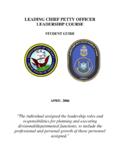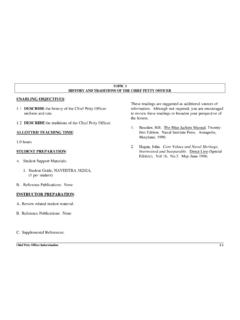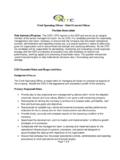Transcription of EVALUATION OF THE CHIEF EXECUTIVE - bdrconsultants.com
1 EVALUATION OF THE CHIEF EXECUTIVE A Briefing for Non-Profit Boards of Directors Prepared by: BERKELEY DEVELOPMENTAL RESOURCES Briefing, EXECUTIVE EVALUATION Page 2 This briefing was prepared for the in-service education of not-for-profit Boards that must update or formalize their process for evaluating the CHIEF EXECUTIVE . These materials can be used as a pre-reading document provided to Board members in advance of an active discussion at a regular meeting. While the presentation has been designed to focus rapidly on the most relevant points, it is likely that Board members will have questions or comments or modifications to suggest on specific issues pertinent to the particular Board in question. Outline of Key Points: 1. What is EXECUTIVE EVALUATION ? 2. What is the role of a Board in EXECUTIVE EVALUATION ? 3. Methods and Processes for EXECUTIVE EVALUATION 4. Problems to Avoid 5. Content Areas Generally Included 6.
2 Recommended Process 7. Sample EVALUATION Form Briefing, EXECUTIVE EVALUATION Page 3 Other names for this process are performance management or performance appraisal . Ideally, the performance review of executives fits with an overall management philosophy of an organization. In particular, the EVALUATION of an EXECUTIVE works best if the organization is disciplined about setting goals, reviewing progress, and making improvements at all levels, from Board actions through staff management. Good performance review processes are helpful in making appropriate compensation decisions, and they should also be useful in guiding the priorities set for professional development activities. What is EXECUTIVE EVALUATION ? The process of planning and reviewing the performance of senior management. A means of demonstrating organizational stewardship and accountability to stakeholders. A means of maintaining alignment between goals set and achievements reached.
3 An element of decisions about compensation. A means of determining the need for further professional development, education, or training. Briefing, EXECUTIVE EVALUATION Page 4 Good working relationships between executives and Boards are important, and they create an opportunity and a challenge. (Unsatisfactory relationships are even more challenging.) The opportunity is that in a relationship of trust and support, Board members and CHIEF executives can have an honest dialogue about what is being accomplished, where the gaps may be, and how to maintain progress. Good relationships promote candor and constructive planning. On the challenge side, there are two potential problems. One challenge is that Board members may represent a diverse group of voices that may not be unified in their expectations of the CHIEF EXECUTIVE . Another challenge is that when relationships are close, supportive, and friendly, there can be a reluctance to bring up areas of performance that need improvement and a tendency to avoid conflict.
4 What is the role of a Board in EXECUTIVE EVALUATION ? Sets the annual objectives/goals for the CHIEF EXECUTIVE , reviews results and achievements annually, makes compensation decisions. EVALUATION responsibility usually held by a smaller group within the Board eg. EXECUTIVE Committee, Compensation Committee, Nominating Committee. Need to balance relationship of support and trust with a relationship of accountability. Briefing, EXECUTIVE EVALUATION Page 5 A good rule of thumb for performance EVALUATION is no surprises . The end-of-period appraisal should reflect the tone and direction of feedback provided at earlier junctures. The best assurance of such coherence is that the EVALUATION be conducted versus known and established expectations. Each organization has its own culture and degree of structure or formality in the processes by which it is managed. In particular, it is important to decide whether the performance will be by the numbers or whether it will include variables that are based on subjective assessment.
5 Both are legitimate, especially with respect to the most senior leader of an organization. While not essential, some form of feedback from more than one angle of vision increases the validity of the performance assessment. However, care must be taken with assessments done by subordinates. Personal interviews by Board members with selected staff regarding EXECUTIVE strengths and weaknesses will minimize the possibility of retaliatory negative input, but may also limit the candor that is sometimes available from surveys. Performance feedback should be provided to the CHIEF EXECUTIVE in written and verbal form, through the authorized representative of the Board (Board Chair or Chair of Compensation Committee, etc.). Methods and Processes for EXECUTIVE EVALUATION : A book-end process --- performance assessed VERSUS objectives or expectations set earlier. Matters of style: how formal versus informal; how much driven by formula versus Board discretion. Multi-source feedback increases validity (Board members, subordinate staff, external contacts).
6 Combination of written and verbal communication. Briefing, EXECUTIVE EVALUATION Page 6 These advisories are intended to ensure that the process has INTEGRITY, OBJECTIVITY, and CONSTRUCTIVE VALUE. Further, it is important to realize that almost any Board or staff activity such as EXECUTIVE EVALUATION can be hijacked in the service of an un-acknowledged conflict that may need to be addressed. Such an issue may be one that is completely unrelated to the problem of EXECUTIVE EVALUATION , such as which constituency has established the greatest level of influence on the Board, or how will the Board signal its values to outside observers. Problems to Avoid: Don t evaluate unless you have set standards against which to measure performance. Don t use ratings that only measure popularity or personality rather than results. Don t deliver an EVALUATION of raw numbers or scores; provide context and narrative commentary. Don t politicize the process be aware if performance EVALUATION is being used as a platform for working out strategy differences or power issues requiring attention from the Board or Director.
7 Briefing, EXECUTIVE EVALUATION Page 7 Content Areas Generally Included: Evaluate the WHAT and the HOW (Results that should be accomplished, behaviors through which leadership is demonstrated.) Examples of WHAT : Fulfillment of Mission / Vision / Strategy Achievement of Specific Annual Priorities or Goals Strategic Leadership and Resource Development Operational or Program Effectiveness Fiscal and Staff Management Public Relations and Advocacy Examples of HOW : Personal Qualities (Integrity, Flexibility, Commitment)Interpersonal Skills (Communications, Influence) Leadership Skills (Trust, Vision, Team Development) Briefing, EXECUTIVE EVALUATION Page 8 Recommended Proces: Establish which committee or persons shall have ongoing director EVALUATION responsibility. (Do the Bylaws stipulate this already?) Establish an annual cycle with calendar dates Approval of Coming Year Objectives by X date; Review of Previous Year s Performance by Y date; Compensation Actions by Z date.
8 Use a written EVALUATION form. Start with a relatively simple form*; get more detailed in the future, as needed. (*Sample attached.) Invite feedback from broader group than those who have responsibility for conducting the assessment. For example, ask all Board members for their written input, and seek input from selected members of staff, external contacts, or client representatives. Compile feedback into a performance EVALUATION that contains: a) Overall assessment; b) Affirmation of strengths and achievements; c) Discussion of any gaps that are of concern; d) Suggestions for future professional development. While compensation actions may be independent of the EVALUATION , pay decisions should not be in contradiction of the message of the EVALUATION . CHIEF EXECUTIVE Performance Review Form CHIEF EXECUTIVE PERFORMANCE REVIEW (Adapted from the form recommended by the National Center for Non-Profit Boards.) Part A: Organizational Responsibilities 1.
9 Vision, Mission, & Strategy: How satisfied are you that the CHIEF EXECUTIVE has a clear understanding of the mission and strategy of the organization, and plays a key role in translating that mission into realistic action? Exceptionally Satisfied Satisfied Very Unsatisfied Cannot Assess Please Comment: 2. Achievement of Results: How satisfied are you that the CHIEF EXECUTIVE has accomplished the objectives and priorities set by the Board for the performance period? Exceptionally Satisfied Satisfied Very Unsatisfied Cannot Assess Please Comment: CHIEF EXECUTIVE Performance Review Form 3. People Management: How satisfied are you that the CHIEF EXECUTIVE has selected and developed qualified staff and built morale among staff, volunteers, and consumers? Exceptionally Satisfied Satisfied Very Unsatisfied Cannot Assess Please Comment: 4. Program Management: How satisfied are you that the CHIEF EXECUTIVE has appropriate knowledge of the organization programs and services, and provides suitable oversight for the provision of high quality programs and services?
10 Exceptionally Satisfied Satisfied Very Unsatisfied Cannot Assess Please Comment: 5. Effectiveness in Fund Raising and Resource Development: How satisfied are you that the CHIEF EXECUTIVE is an effective fundraiser, working well with all constituencies and donors to generate needed resources for the fulfillment of the organization s mission? Exceptionally Satisfied Satisfied Very Unsatisfied Cannot Assess Please Comment: CHIEF EXECUTIVE Performance Review Form 6. Fiscal Management: How satisfied are you that the CHIEF EXECUTIVE is knowledgeable regarding financial matters, and has established a system that allows for accurate accounting and informed financial decision-making? Exceptionally Satisfied Satisfied Very Unsatisfied Cannot Assess Please Comment: 7. Operations Management: How satisfied are you that the CHIEF EXECUTIVE has assured that the organization has suitable systems, policies, and processes for: accounting and fund management, personnel management, office space, information technology, and risk management?









